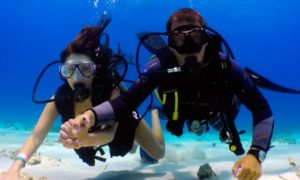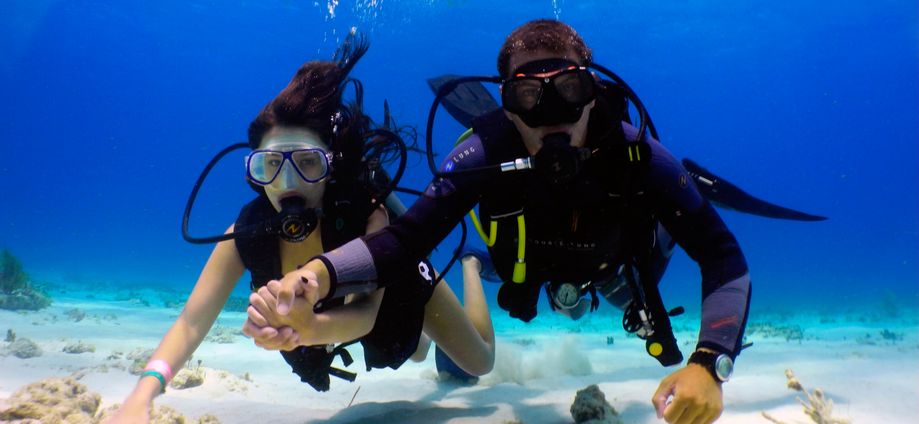
Scuba diving is definitely an other-worldly experience that you should cherish once in your lifetime. Imagine yourself diving to the colourful coral reefs that decorate the ocean floors, the shoal of fish that swim past you without even bother about your presence, and the amazing marine natural world under the waters — everything you come across beneath the ocean surface will always be surprisingly new to your eyes (unless your name is Aquaman!). What could be more redeeming and fascinating than delving deeper into a world that you never belonged to, right?
Diving is not just about the pleasures of watching what’s happening under the calm blue waters but also about an experience away from all the hustle and noises of the world. When you’re under the water, it is just you and your thoughts. That’s why, experiences like deep-sea diving, snorkelling, or scuba diving never escapes a globetrotter’s bucket list.
So, if you’re a sucker for underwater diving experiences, if you have wondered what lies beneath the pristine blue waters of the oceans and seas, and if you’ve always believed that travel does not confine to just exploring the lands but also to unravel the secrets of the ocean depths and azure skies, by the time you read this list of the best Scuba diving destinations across the globe, we bet you’ll be spotted outside your home with a backpack full of swimsuits and diving supplies!
1) Barracuda Point, Malaysia

Situated in the north-eastern part of the Sipadan Island in Malaysia, the Barracuda Point is definitely the no.1 go-to point for scuba divers from around the globe. Starting off as a slow drift, the dive takes you along an underwater wall that goes 22 metres deep. On an average day, you can see shoals of barracuda, batfish, bigeye trevally, and silver jackfish that often make a tornado-formation at the point.
Home to thousands of barracudas, hundreds of turtles, and schools of oceanic whitetip sharks, Barracuda Point feels just out of a novel or movie based on underwater communities! While exploring, just be careful of the strong currents that could occasionally catch you off-guard.
There’s so much underwater beauty at this dive location, making it one of the 5 best Scuba diving spots of all time voted. The visibility ranges from 10 metres to an impressive 30 metres — no wonder, this is one of the best go-to places for underwater photographers! The point is open and accessible at all times of the year, and there isn’t a particular season to visit the point. However, the bookings should be done in advance, as the daily permits are quite limited. Not to mention, Barracuda Point is not for wreck divers and beginners.
2) Blue Corner Wall, Palau

Blue Corner Wall in Palau is a world-class diving destination, often ranked on the list of ultimate diving destinations across the globe. The diving spot is situated 25 miles south-west of Koror and at the North-west end of Ngemelis Island.
Blue Corner Wall is a perfect amalgamation of the everything you expect from a diving spot — healthy and colourful coral reefs, untouched natural setting, historically important wrecks, and of course, mega shoals of fish, endless bales of hawksbill turtles, and schools of sharks. While schooling trevally, barracudas, blacktip reef sharks, whitetips, hammerhead sharks, eagle rays, and dolphins are a common sight at all times of the year, you can even spot rarer whale sharks and manta rays during the months of January-April.
Whether you’re a beginner or an advanced diver, Blue Corner Wall is a great choice for you. However, you might not find any particular activity for non-divers here. Novices can dive when there is no current, as swift currents could be a challenge to even seasoned divers.
The optimal diving conditions exist from November to May, but the dive spot is no less attractive in any other month of the year. The visibility is excellent, as it can reach up to a range of 40 metres, despite the current. Though the region lies beyond the path of the typhoons, occasional high winds and storms can be seen in the Typhoon season (June – December).
3) Yongala, Australia

Yongala in Australia is often referred to as a wreck diver’s paradise because of its historic S.S. Yongala shipwreck. The Yongala incident happened in 1911 during a cyclone in the South Pacific waters, but more than 70% of the ship is still intact. The ship was only discovered 40 years later in its final resting place, which falls close to the Great Barrier reef, approximately 48 nautical miles south-east of Townsville.
The Yongala dive has ever since been a popular diving destination among wreck divers. However, since the wreck has been protected, divers are no longer allowed to enter inside the wreck. The best thing about this wreck is, this is the only big structure in a vast stretch of the sandy ocean bottom, making it one of the best spots to find all sorts of marine creatures. In and around the multicoloured coral layers that have formed over the wreck, you can find huge shoals of the immaculate, purple-banded angelfish, thousands of yellow perch hovers, giant coral trouts, napoleon wrasse, and squadrons of bright, multicoloured nudibranchs.
Yongala dive spot is accessible at any time of the year with exceptions during unusual tides, currents, high winds, and rough sea conditions. In such conditions, either the dives are cancelled or redirected to the Great Barrier Reef.
4) Thistlegorm, Egyptian Red Sea
 Located towards the north of the Red Sea, the Thistlegorm is another major shipwrecks that attract scuba junkies from around the world. More than anything else, it is the artefacts that you see inside the S.S. Thistlegorm wreck that makes this a dive into the history. 30 meters under the water, you can see coral covered locomotives, army tanks, trucks, jeeps, motorcycles, and rifles inside the WW II wreck. Since the depth is beyond 20 metres, the dive spot is reserved for advanced divers only.
Located towards the north of the Red Sea, the Thistlegorm is another major shipwrecks that attract scuba junkies from around the world. More than anything else, it is the artefacts that you see inside the S.S. Thistlegorm wreck that makes this a dive into the history. 30 meters under the water, you can see coral covered locomotives, army tanks, trucks, jeeps, motorcycles, and rifles inside the WW II wreck. Since the depth is beyond 20 metres, the dive spot is reserved for advanced divers only.
The marine ecosystem that grew around the wreck includes multicoloured coral reefs brimming with life — you could easily see shoals of barracudas, napoleon wrasse, snappers, jacks, and all the common reef fish of the Red Sea.
Being one of the most famous dives in the Red Sea region, the dive location is quite crowded and chances of losing your group are very high. The current can also be quite strong in these regions and the visibility, which in normal conditions is quite good, can be reduced due to the rush of silt and minerals during strong currents.
5) Great Blue Hole, Belize
Thousands of scuba divers visit the Great Blue Hole annually, not just because of its remarkable sinkhole that measures up to 300 metres across and 400 meters deep, but also because of its impeccable beauty, bizarre limestone formations, and the exotic marine ecosystem. If you’re an advanced scuba diver and diving underneath monstrous overhangs don’t scare you, the Great Blue Hole can be a revelation into one of the best-kept secrets in the whole planet. However, beginners and snorkelers can explore the fringing reefs and the Half Moon Caye Wall.
Apart from the sea fans, sponges, and a wide variety of corals, the inhabitants of this marine natural wonder include angelfish, butterfly fish, and shrimps. The marine life is a lot scantier in this region, but you can occasionally find a lonely hammerhead shark passing by you!
The Great Blue Hole is a round-the-year diving destination, but the best diving conditions exist from March till December.
6) Manta Ray Night Dive, Hawaii
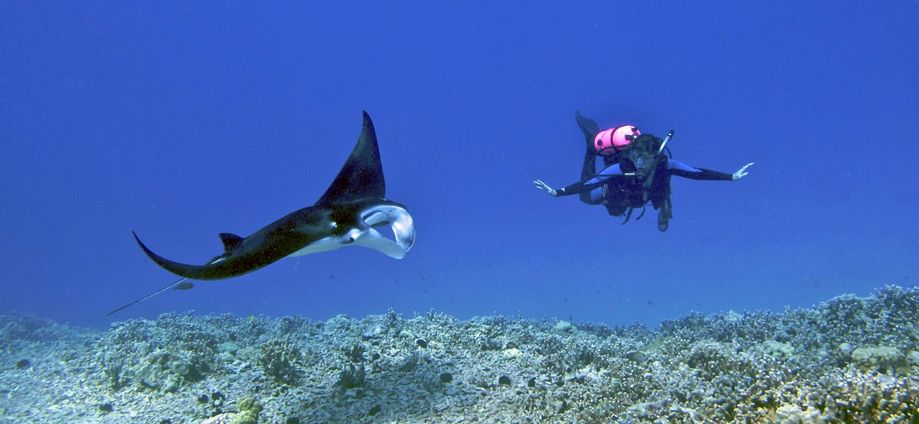
One of the biggest island activities that you shouldn’t miss when you visit Hawaii is the Manta Ray night dive off the coast of Kona. As the name suggests, this dive is solely done to visit these large creatures called manta rays that, seemingly, flying around in the ocean feeding on phytoplankton and zooplankton.
While one of the most satisfying things you could do is swimming around with these beautiful manta rays, what makes the night dive more attractive is the surreal feeling when you dive alongside these magnificent creatures — they often swim around you in circles, reflecting the light from your glow sticks! It’s definitely otherworldly, and that’s why it becomes a must-do activity for diving enthusiasts. The dives are only offered to certified scuba divers, but you can choose night snorkelling too if you don’t have a diving certification. Like most diving destinations, the manta ray night dive is also accessible at any time of the year, but bookings should be done only after consultation as there could be times when there are no manta rays around.
7) Navy Pier, Australia
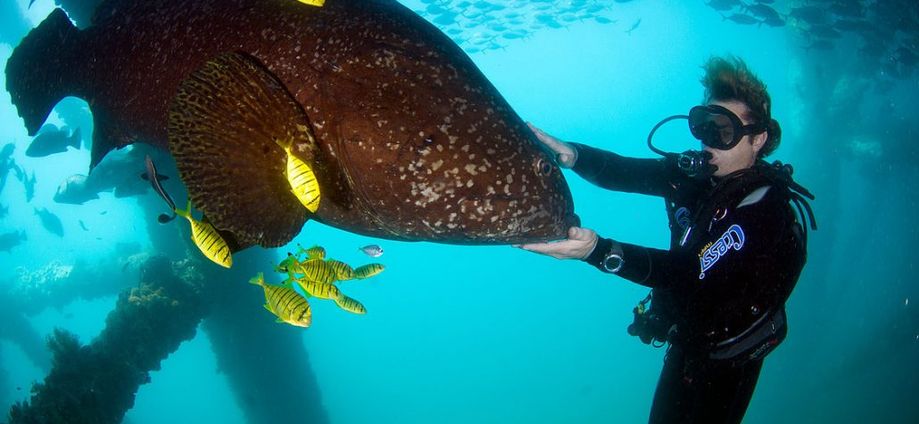
The Navy Pier is one of the top 10 diving sites in Australia and also one of the best shore dives in the world. Located in Exmouth, this incredible diving destination is right beneath a fully operational Australian Naval Jetty, near the Ningaloo Reef.
Due to the limited access and lack of human interference, the marine life in the Navy Pier has grown substantially, making it a thriving universe of exotic marine creatures. The Navy Pier is accessible to all, regardless of whether you have a scuba diving experience or not, because of its shallow depth (hardly 15 meters under the water) and absence of any current. Best to say, this is one of the safest and the most attractive scuba diving places that photographers and diving enthusiasts of any experience can visit. Apart from the schools of common reef fish like barracudas and trevallies, the rich marine ecosystem of the Navy Pier also includes whitetips, the grey nurse, creepy-looking wobbegong sharks, nudibranchs, stonefish, and scorpionfish.
You can dive at any time of the year, and there’s no need for any particular caution in this diving spot. We also recommend this spot for night dives too, in order to get some spectacular ethereal experience!
8) Tulamben & Liberty Dive, Indonesia
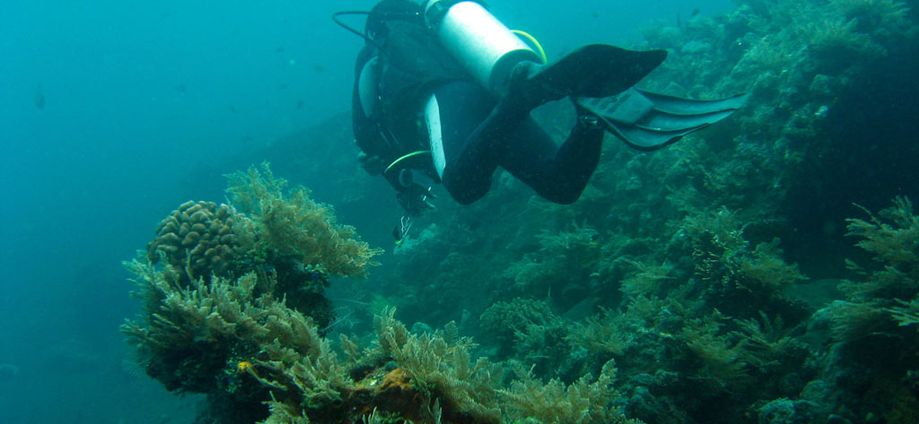
The Tulamben and USS Liberty dive off the coast of Bali is something that you should not miss on your trip to Bali. Best known for its wreckage of the World War II cargo ship name USS Liberty, this diving spot is also known for its colourful soft corals like hydroids, feather stars, and crinoids that dominate the wreck as well as the rocks surrounding the dive location.
The Tulamben Wall and the Wreck are the megacities for marine life. Due to the crystal-clear visibility and the presence of multicoloured corals and fish in this region, it is one of the favourite spots for photographers. Tulamben is home to the sunfish, giant shrimps, peacock groupers, angelfish, napoleon fish, scribbled filefish, and great barracudas. You can also spot eel colonies and schools of nuzzlefish in the rocky bottoms.
The Tulamben & Liberty Dive in Bali attracts both beginners and advanced divers alike. Though the diving season spans throughout the year, it could be difficult to dive during the winter months (mostly December – March).
9) Cayman Islands

The Cayman Islands is a haven for scuba divers, and have been one of the cradles of early scuba divers. With some of the coolest coral formations along the deep drop-offs and beautiful walls, Grand Cayman has become the most visited island among the three in the archipelago. However, Little Cayman is no less of an attraction with its Bloody Bay Wall Marine Park that got its name from the vibrant, often reddish, colours and wicked drop-offs!
Turtles seem to be all over the place during a dive unless you’re completely covered by a shoal of barracudas, sergeant majors, angelfish, yellowtail snappers, andor parrotfish. The region is blessed with all sorts of marine creatures that are not just limited to these common reef fish, but also stingrays, eagle rays, and even moray eels! The colourful soft corals along the walls also offer you a chance to indulge in some incredible underwater photography adventure.
If you’re planning to visit this amazing destination, the Cayman Islands offer year-long diving. However, it is best to opt out of diving during the months of June till October, as it is the hurricane season in the Caribbean.
10) Andaman Islands, India

The Andaman Islands is an archipelago tucked away in a silent corner of the Bay of Bengal, making it one of the most exotic destinations on the planet. Out of more than 500 islands, only a handful are inhabitable by people other than the aboriginals. Imagine how untouched the whole setting is?
It’s not surprising that the pristine natural environment has turned Andaman into a stunning scuba diving heaven. The most prominent of the diving spots are near the Havelock and Neil Islands. A dive near these amazing locations allows you to explore the bright and multi-coloured corals and the heavenly seabed gardens while swimming alongside little devil rays, manta rays, dugongs, and schools of humpback parrotfish, lionfish, barracudas, big-eyed trevally, batfish, angelfish, and a lot more of these beautifully-patterned marine creatures.
With year-long accessibility, beginners can scuba dive in the Andaman at any point of time, as they’ll be diving in the shallower regions. As for advanced divers, January through May could be the best time in order to go on deeper dives.
Now, I believe you’re all set to spoil yourself in these best underwater dive locations in the world. Some of these places don’t even need a visa to visit. So, all you need to do is, just pack your backpack and get in touch with us using our contact page. We’ll take care of the rest!


